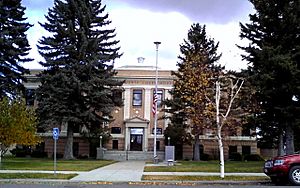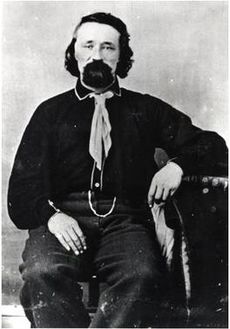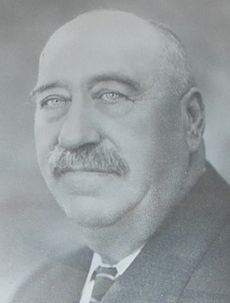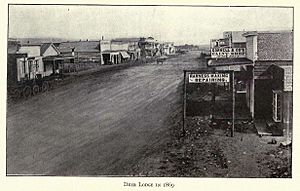Deer Lodge, Montana facts for kids
Quick facts for kids
Deer Lodge
|
|
|---|---|
|
City
|
|
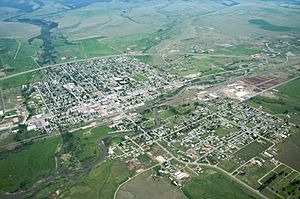 |
|
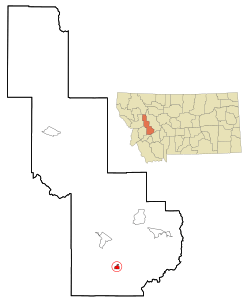
Location of Deer Lodge, Montana
|
|
| Country | United States |
| State | Montana |
| County | Powell |
| Area | |
| • Total | 1.55 sq mi (4.01 km2) |
| • Land | 1.55 sq mi (4.01 km2) |
| • Water | 0.00 sq mi (0.00 km2) |
| Elevation | 4,538 ft (1,383 m) |
| Population
(2020)
|
|
| • Total | 2,938 |
| • Density | 1,895.48/sq mi (731.80/km2) |
| Time zone | UTC-7 (Mountain (MST)) |
| • Summer (DST) | UTC-6 (MDT) |
| ZIP code |
59722
|
| Area code(s) | 406 |
| FIPS code | 30-19825 |
| GNIS feature ID | 2410310 |
Deer Lodge is a city in Montana, United States. It is the main town, or county seat, of Powell County. In 2020, about 2,938 people lived there.
Contents
About Deer Lodge
Deer Lodge is well-known for being home to the Montana State Prison. This prison is a big employer in the area. The Montana State Hospital is also nearby in Warm Springs. Deer Lodge was once an important railroad town. It was a main hub for the Chicago, Milwaukee, St. Paul and Pacific Railroad, also called "the Milwaukee Road." The railroad stopped running here in 1980.
The current Montana State Prison is located about 3.5 kilometers (2.2 miles) west of town. The old prison building is now a museum. It is called the Old Prison Museum. This museum complex includes a theater and museums for old cars and antiques. You can also see an old "Little Joe" electric train engine there.
Deer Lodge is also home to the Grant-Kohrs Ranch National Historic Site. This site teaches about the history of cattle ranching on the frontier. It was the home of Conrad Kohrs, a famous "Cattle King" of Montana. His land once covered over a million acres across Montana, Wyoming, and Canada. Johnny Grant, a fur-trader, built the Grant-Kohrs ranch in 1862. He encouraged people to settle in Deer Lodge. The area had a nice climate and lots of grass for cattle and horses. The city's name comes from a natural salt lick for deer. This valley was a safe place for local wildlife to stay in winter.
Deer Lodge was also where the College of Montana was located. This was the first college in the state.
History of Deer Lodge
People started keeping good records of the Deer Lodge Valley in the early 1860s. This is when European-Americans began living permanently in the valley.
Early Days and Fur Trade
Before 1860, no single American Indian group owned the Deer Lodge Valley. Different groups would gather there, sometimes for horse races. Tribes like the Flatheads and Pend d'Oreilles passed through. They used the valley as a route to hunt buffalo in the east.
The first European-American explorers, Lewis and Clark, passed by in 1805–1806. They did not enter the valley. Early trappers called the valley "the Deer House Plains." The Clark Fork river was known by different names over time. Catholic Father Pierre-Jean De Smet brought the first wagons through the valley in 1841.
In 1846, the Deer Lodge Valley became part of the United States. This happened with the signing of the Oregon Treaty. The valley was part of different territories before Montana Territory was created in 1864.
More European-Americans settled in the valley in the 1850s and 60s. The main settlement was at present-day Deer Lodge. Trappers began keeping horses and cattle in the valley during winters. Gold was also found nearby. In 1860–62, Lt. John Mullan built the Mullan Road. This road connected Walla Walla, Washington, to Fort Benton. The Mullan Road went through the north end of the Deer Lodge Valley.
European-American Settlement and Gold Rush
John Francis (Johnny) Grant built the first permanent homes in the valley in 1859–60. He had been grazing animals there for years. In 1860, he brought other traders and their families to the valley. They chose to build homes at the site of present-day Deer Lodge. This area was already a seasonal settlement called Spanish Fork.
In 1861, the Stuart brothers started another settlement called American Fork. Johnny Grant moved his family to his new house in Deer Lodge. This is where the Grant-Kohrs Ranch National Historic Site is today. Gold discoveries to the south caused some people to leave the valley. But starting in 1864, Deer Lodge City grew quickly. It became a supply base for mines in the mountains.
Montana Territory and County Seat
By 1861–1862, Spanish Fork was often called Cottonwood. In 1862, a committee was formed to plan the town site. They decided to call it LaBarge City. Later, it was renamed Idaho City. When Montana Territory was formed in 1864, the name became Deer Lodge City.
Montana's first government set up the boundaries for Deer Lodge County. The main town for the county was Silver Bow City. But in September 1865, voters moved the county seat to Deer Lodge City.
By 1866, Johnny Grant and many of his friends moved away. They were not happy with the growing number of new settlers. Grant sold his land to Conrad Kohrs. In 1867, many families moved to Canada.
In 1869, the Territorial Prison was built in Deer Lodge. Also that year, the town map for Deer Lodge City was officially recorded. In 1878, the Montana Collegiate Institute was started in Deer Lodge City. It opened for classes in 1883 and closed in 1914.
State of Montana and Powell County
Deer Lodge City became an official city in 1888. Montana became a state in 1889. There was a big debate about where the state capital should be. Helena won in 1894. In 1896, Anaconda took the Deer Lodge County seat away from Deer Lodge. This led to a disagreement that ended with the creation of Powell County in 1901. Deer Lodge became the county seat for Powell County.
Frank Conley's Influence
After Montana became a state, Frank Conley helped run the Montana State Prison. He was later appointed warden in 1908. Conley was mayor of Deer Lodge City many times. He served from 1892 to 1928, with some breaks. He was known as one of the longest-serving mayors in American history.
Mayor Conley helped bring the main offices and shops of the Milwaukee Road railroad to Deer Lodge City in 1910. Over the next ten years, he helped build up the town's services. This was to support the fast-growing population. He was also responsible for building the City Hall.
Montana State Prison Today
In 1977–79, all prisoners were moved to a new state prison outside Deer Lodge. The old prison building in town is now managed as a museum. It is run by the Powell County Museum & Arts Foundation.
Economic Changes
Interstate 90 was built around Deer Lodge in 1960. This meant less traffic went through the town. In 1961, the Milwaukee Road stopped its passenger trains. All Milwaukee Road passenger service to Deer Lodge ended by 1964.
In the 1970s, the Anaconda Copper Company faced money problems. It eventually merged with ARCO in 1977. By 1982, ARCO had closed the copper smelter in Anaconda. They also stopped mining copper in Butte. In 1980, the Milwaukee Road closed its western railway. All its tracks from Seattle to Miles City were removed.
Geography and Climate
Deer Lodge covers about 4.01 square kilometers (1.55 square miles) of land. There are small creeks in and near town. These include Cottonwood Creek and Peterson Creek.
Climate in Deer Lodge
Deer Lodge has big temperature changes between seasons and day and night. This is because it is high up and dry. Summers are warm to hot, and winters are cold. Winters can sometimes be very cold.
| Climate data for Deer Lodge, Montana, 1991–2020 normals, extremes 1893–present | |||||||||||||
|---|---|---|---|---|---|---|---|---|---|---|---|---|---|
| Month | Jan | Feb | Mar | Apr | May | Jun | Jul | Aug | Sep | Oct | Nov | Dec | Year |
| Record high °F (°C) | 62 (17) |
69 (21) |
73 (23) |
84 (29) |
94 (34) |
100 (38) |
108 (42) |
103 (39) |
99 (37) |
87 (31) |
73 (23) |
66 (19) |
108 (42) |
| Mean maximum °F (°C) | 50.6 (10.3) |
52.9 (11.6) |
62.6 (17.0) |
73.5 (23.1) |
80.8 (27.1) |
86.4 (30.2) |
91.9 (33.3) |
91.2 (32.9) |
86.8 (30.4) |
76.7 (24.8) |
60.6 (15.9) |
50.3 (10.2) |
93.1 (33.9) |
| Mean daily maximum °F (°C) | 33.2 (0.7) |
36.0 (2.2) |
44.3 (6.8) |
52.9 (11.6) |
62.2 (16.8) |
68.5 (20.3) |
79.1 (26.2) |
79.4 (26.3) |
69.6 (20.9) |
55.4 (13.0) |
40.2 (4.6) |
31.3 (−0.4) |
54.3 (12.4) |
| Daily mean °F (°C) | 22.0 (−5.6) |
24.5 (−4.2) |
31.8 (−0.1) |
39.4 (4.1) |
47.9 (8.8) |
54.1 (12.3) |
61.6 (16.4) |
60.8 (16.0) |
52.1 (11.2) |
40.6 (4.8) |
28.3 (−2.1) |
20.9 (−6.2) |
40.3 (4.6) |
| Mean daily minimum °F (°C) | 10.7 (−11.8) |
13.1 (−10.5) |
19.3 (−7.1) |
25.8 (−3.4) |
33.7 (0.9) |
39.8 (4.3) |
44.2 (6.8) |
42.2 (5.7) |
34.6 (1.4) |
25.8 (−3.4) |
16.3 (−8.7) |
10.5 (−11.9) |
26.3 (−3.1) |
| Mean minimum °F (°C) | −14.7 (−25.9) |
−10.3 (−23.5) |
0.9 (−17.3) |
11.5 (−11.4) |
18.4 (−7.6) |
28.3 (−2.1) |
34.0 (1.1) |
29.8 (−1.2) |
20.9 (−6.2) |
7.5 (−13.6) |
−4.4 (−20.2) |
−12.9 (−24.9) |
−23.2 (−30.7) |
| Record low °F (°C) | −39 (−39) |
−41 (−41) |
−29 (−34) |
−8 (−22) |
7 (−14) |
22 (−6) |
20 (−7) |
19 (−7) |
9 (−13) |
−15 (−26) |
−38 (−39) |
−42 (−41) |
−42 (−41) |
| Average precipitation inches (mm) | 0.48 (12) |
0.68 (17) |
1.28 (33) |
1.08 (27) |
2.19 (56) |
2.66 (68) |
1.51 (38) |
1.32 (34) |
1.35 (34) |
1.00 (25) |
0.51 (13) |
0.50 (13) |
14.56 (370) |
| Source 1: NOAA | |||||||||||||
| Source 2: National Weather Service | |||||||||||||
Population Information
| Historical population | |||
|---|---|---|---|
| Census | Pop. | %± | |
| 1870 | 788 | — | |
| 1880 | 941 | 19.4% | |
| 1890 | 1,463 | 55.5% | |
| 1900 | 1,324 | −9.5% | |
| 1910 | 2,570 | 94.1% | |
| 1920 | 3,780 | 47.1% | |
| 1930 | 3,510 | −7.1% | |
| 1940 | 3,278 | −6.6% | |
| 1950 | 3,779 | 15.3% | |
| 1960 | 4,681 | 23.9% | |
| 1970 | 4,306 | −8.0% | |
| 1980 | 4,023 | −6.6% | |
| 1990 | 3,378 | −16.0% | |
| 2000 | 3,421 | 1.3% | |
| 2010 | 3,111 | −9.1% | |
| 2020 | 2,938 | −5.6% | |
| source: U.S. Decennial Census |
|||
In 2020, the population of Deer Lodge was 2,938. This is less than its highest population in 1960.
2010 Census Details
In 2010, there were 3,111 people living in Deer Lodge. There were 1,386 households. Most residents (96.8%) were White. About 1.2% of the population was Hispanic or Latino.
About 27.9% of households had children under 18. Many households (43.9%) were married couples. The average household had 2.19 people. The average family had 2.79 people. The median age in the city was 45.7 years. About 22.3% of residents were under 18.
Education in Deer Lodge
The Deer Lodge School District has two parts. These are the Elementary School District and the Powell County High School District. All of Deer Lodge is in both districts.
Deer Lodge Schools teach students from kindergarten to 12th grade. In 2022, the elementary district had 400 students. Powell County High School is in Deer Lodge. In 2022, the high school had 175 students. The school's sports teams are called the Wardens. They won their first state championship in golf in 2005.
The William K. Kohrs Memorial Library was built in Deer Lodge in 1902. It is the only public library in Powell County. Conrad Kohrs and his wife built it for $30,000. They built it to honor their son. The library is similar to the Carnegie Libraries.
Important Services
Deer Lodge-City-County Airport is a public airport. It is located 2 miles west of town. The closest commercial airport is Bert Mooney Airport in Butte.
Deer Lodge Medical Center is a hospital in town. It provides important medical care.
Media and Film
The Silver State Post is the only newspaper in Powell County. KQRV (96.9 FM) is a local radio station in Deer Lodge.
Movies Filmed in Deer Lodge
Deer Lodge has been a location for several movies, including:
- Rancho Deluxe (1975)
- Heaven's Gate (1980)
- Fast-Walking (1982)
- Runaway Train (1985)
- Diggstown (1992)
- F.T.W. (1994)
- Love Comes to the Executioner (2006)
- Iron Ridge (2008)
Notable People
Many interesting people have lived in Deer Lodge. Here are a few:
- John Bozeman, who founded the city of Bozeman, Montana.
- William H. Clagett, a lawyer and U.S. Representative. He helped create Yellowstone National Park.
- William Andrews Clark, a U.S. Senator and famous "Copper King."
- Pierre-Jean De Smet, who started St. Mary's Mission.
- William W. Dixon, a lawyer and U.S. Representative.
- Eric Funk, a Composer and professor at Montana State University.
- Phil Jackson, a famous NBA player and coach.
- Conrad Kohrs, one of the co-founders of Deer Lodge.
- Elizabeth Lochrie, an artist and lecturer.
- John Mullan, who surveyed routes for a railroad.
- Jesse Mullen, a Montana media figure and writer.
- Jean Parker, an actress born in Deer Lodge.
- Edgar Samuel Paxson, a frontier artist.
- Jean'ne Shreeve, a chemist.
- Granville Stuart, another co-founder of Deer Lodge, Montana.
- Patricia Nell Warren, a writer and great-granddaughter of Conrad Kohrs.
Images for kids
See also
 In Spanish: Deer Lodge (Montana) para niños
In Spanish: Deer Lodge (Montana) para niños



